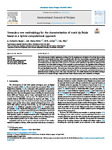Towards a new methodology for the characterisation of crack tip fields based on a hybrid computational approach
| dc.contributor.author | Camacho-Reyes, A | en |
| dc.contributor.author | Vasco-Olmo, JM | en |
| dc.contributor.author | James, MN | en |
| dc.contributor.author | Diaz, FA | en |
| dc.date.accessioned | 2022-06-21T10:11:08Z | |
| dc.date.available | 2022-06-21T10:11:08Z | |
| dc.date.issued | 2022-09-01 | en |
| dc.identifier.issn | 0142-1123 | en |
| dc.identifier.uri | http://hdl.handle.net/10026.1/19328 | |
| dc.description.abstract |
This work presents a hybrid optimisation technique for the simultaneous calculation of crack tip characterising parameters and its spatial location, which can significantly affect the characterising parameters if the position used is inaccurate. The hybrid technique combines initial use of a genetic algorithm to obtain a well-conditioned set of initial parameter values that is then passed to an interior point optimisation algorithm for subsequent fast optimisation. Use of the hybrid technique is also amenable to easy automation. The capability of the technique is demonstrated using the CJP crack tip field model, with digital image correlation (DIC) being used to measure the 2D crack tip displacement field. This model was chosen, not only for its demonstrated sensitivity to accuracy in crack tip location, but also for its proven utility in providing effective crack growth correlation in the presence of plasticity-induced shielding across a wide range of growth rates. The results obtained from the hybrid technique are shown to be reliable through comparison with results obtained using other established techniques. | en |
| dc.language.iso | en | en |
| dc.title | Towards a new methodology for the characterisation of crack tip fields based on a hybrid computational approach | en |
| dc.type | Journal Article | |
| plymouth.volume | 162 | en |
| plymouth.publication-status | Accepted | en |
| plymouth.journal | International Journal of Fatigue | en |
| dc.identifier.doi | 10.1016/j.ijfatigue.2022.106942 | en |
| plymouth.organisational-group | /Plymouth | |
| plymouth.organisational-group | /Plymouth/Faculty of Science and Engineering | |
| plymouth.organisational-group | /Plymouth/Faculty of Science and Engineering/School of Engineering, Computing and Mathematics | |
| plymouth.organisational-group | /Plymouth/Users by role | |
| plymouth.organisational-group | /Plymouth/Users by role/Academics | |
| dc.rights.embargoperiod | Not known | en |
| rioxxterms.versionofrecord | 10.1016/j.ijfatigue.2022.106942 | en |
| rioxxterms.licenseref.uri | http://www.rioxx.net/licenses/all-rights-reserved | en |
| rioxxterms.type | Journal Article/Review | en |


